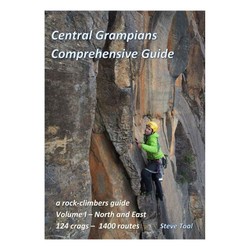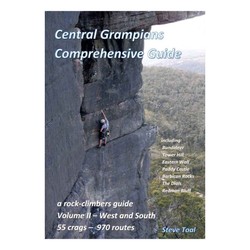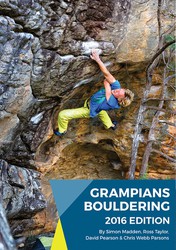Seasonality
Description
Most of the following has been copied directly from Kieran Loughran's excellent Amphitheatre guide - thanks!
'Central Buttress' is the big somewhat scrappy looking area extending right from the Amphitheatre 'Gully', until the cliffline breaks down into a gully before the Grey & Green Walls. It offers a wide variety of climbs with a few outstanding classics. While some of the cliffs do not look particularly attractive at first sight, don't let that put you off. The highlight of this area, and the best section of the entire Amphitheatre apart from 'Taipan Wall', is the recess containing 'Simpleton', 'Missing' and 'Technical Ecstasy'.
'Central Buttress' is in the shade until early afternoon. 'Simpleton' gets sun only on summer evenings. An early start on a hot day can see you up a good climb before the heat of the afternoon. The climbs left of 'Simpleton' appear grey and amorphous but are generally quite steep and more difficult than appearances suggest.
© (willmonks)Access issues inherited from Grampians
Climbing restrictions apply to many crags in Gariwerd/Grampians. Some of these restrictions are likely to change over time as assessments are completed. Tags are being applied to most crags to reflect their current status. Additional access-notes are provided to clarify restrictions where required (and will over-ride this notice). Current and further Parks Victoria advice can be found at https://www.parks.vic.gov.au/places-to-see/parks/grampians-national-park/rock-climbing-in-gariwerd
Approach
Follow the walking track from Flat Rock down into the Amphitheatre for about 150m past 'Epsilon Wall', avoiding any right-hand turns. Follow a faint pad on the left to soon arrive below the Amphitheatre 'Gully'. 'Central Buttress' extends from here to your right.
Descent: Descend via the abseil near 'Simpleton' or the 'Hollow Mountain' walking track towards Summer Day Valley (return into the Amphitheatre is then possible by walking beneath Amnesty, Clicke, Kindergarden and Northern Walls areas). Avoid the horrible dangerous Amphitheatre 'Gully' (which I refuse to call by its traditional name of "the descent gully"!). Parties with novice climbers are strongly advised to use the walking track for descent.
'Simpleton' Abseil Route: This is the only abseil descent from this area, and allows the awful Amphitheatre 'Gully' to be avoided, but it has its own hazards. If you have two 50m ropes, you need to use the old anchors: from the top of 'Simpleton' (near a lonely 4m pine tree), move out to the front of the cliff and scramble down 5 metres to the chains, the scramble is fairly easy but very exposed - one snapped hold or foot slip and you're facing a death fall. If in doubt, keep the rope on. Have slings ready to clip into the anchors, which are now worryingly rusty. It is a 50 metre abseil, and the first 40 metres are free hanging. Abseil ends on long ledge at the base of 'Missing'. Either scramble down the initial slabs of 'Technical Ecstasy' or do a further short abseil from trees. If you take novices on this descent (not recommended) you must be able to rescue them if they get stuck on the long free abseil section. On a pragmatic note, remember that belaying a novice on descent can take just as long as simply walking off.
In May '09 a new anchor was added at the top of the 'Simpleton' corner, and this can be accessed much less dangerously than the original anchor because you don't need to do the scary 5m downclimb. To use this new anchor you need two 60m ropes. With this abseil (using 60m ropes) you will end up on top of the first ledge of Simpleton P1, NOT on the ground. The downclimb from here is pretty easy, but its worthwhile to check it out beforehand.
Climbs are described from left to right.
© (willmonks)Ethic inherited from Grampians
Grampians / Gariwerd access issues have emerged (2019) due to potential risk to the environment and cultural sites. Climbers need to be aware that there are significant Aboriginal sites in the Grampians, especially in cave areas. Please take time to understand the access situation. Leave no trace and climb responsibly.
Please note that due to the fact that the Grampians is a National Park, dogs and other pets are not allowed in the park except in vehicles on sealed roads and in sealed car parks.
===Cliffcare Climber’s Code===
Find out about and observe access restrictions and agreements.
Use existing access tracks to minimise erosion - keep to hard ground & rock surfaces.
Do not disturb nesting birds or other wildlife.
Protect all native vegetation, especially at the base of cliffs. Wire brushing to remove mosses and 'gardening' in cracks and gullies is not permitted. Use slings to protect trees while belaying or abseiling if belay anchors are not provided.
Respect sites of geological, cultural, or other scientific interest. Do NOT develop new climbs in or near Cultural Heritage sites.
Chalk has high visual impact - minimise your use of it. Parks Victoria have requested the use of coloured chalk in Gariwerd.
Minimise the placement of fixed equipment, especially where Trad gear is available. Respect any "no bolting" areas.
Do not leave any rubbish - take it home with you.
Dispose of human waste in a sanitary manner (bury, or even better pack it out). Do not pollute water supplies.
Off-road driving is illegal in Gariwerd.
Keep campsites clean, and do not light campfires outside of official metal fire pits.
For more detailed information visit https://www.cliffcare.org.au/education
Tags
Plan your Trip
Some content has been provided under license from: © Australian Climbing Association Queensland (Creative Commons, Attribution, Share-Alike 2.5 AU)
Hello!
First time here?
theCrag.com is a free guide for rock climbing areas all over the world, collaboratively edited by keen rock climbers, boulderers and other nice folks.You can log all your routes, connect and chat with other climbers and much more...» go exploring, » learn more or » ask us a questionSelected Guidebooks more Hide
Author(s): Steve Toal
Date: 2019
The Central Grampians Comprehensive Guide books are the most extensive climbing guide to the Grampians. With two volumes they cover the popular areas but also many of which have never been in print before.
Volume 1 of the Central Grampians guide covers the North and East regions and features over 1400 routes spread over 124 crags. Painstakingly put together by Steve Toal, his guides have now become the go-to for climbers for the area.
Author(s): Steve Toal
Date: 2019
The Central Grampians Comprehensive Guide books are the most extensive climbing guide to the Grampians. With two volumes they cover the popular areas but also many of which have never been in print before.
Volume 2 of the Central Grampians guide covers the West and South regions and features over 970 routes spread over 55 crags. Painstakingly put together by Steve Toal, his guides have now become the go-to for climbers for the area.
Author(s): Simon Madden, Ross Taylor, David Peason and Taylor Parsons
Date: 2016
ISBN: 9780646955544
"Australia's premier bouldering destination! The new 2016 Edition Grampians Boulder guide authored by Simon Madden, Ross Taylor, David Peason and Taylor Parsons. It contains more than 1300 problems which is double the original guide. Heaps of new information on established areas as well as the inclusion of plenty of boulders and crags not published before. It also features update idiot proof layout and expanded history and culture notes. Get one and start cranking!"
Accommodations nearby more Hide
Share this
Photos Browse all photos
/99/45/9945bdff849bdd6add3268862bd7252f106349c5)
Herbal Sin 21 - The steep start of Herbal Sin with Germinal in the background.
/1c/dd/1cdd3f1d49145c3571e53baadfecf12fdbbfbcdb)
★★ Toothless Tigers 12 - An enjoyable warm up.
Get a detailed insight with a timeline showing
- Ticks by climbers like you
- Discussions of the community
- Updates to the index by our users
- and many more things.
Login to see the timeline!



